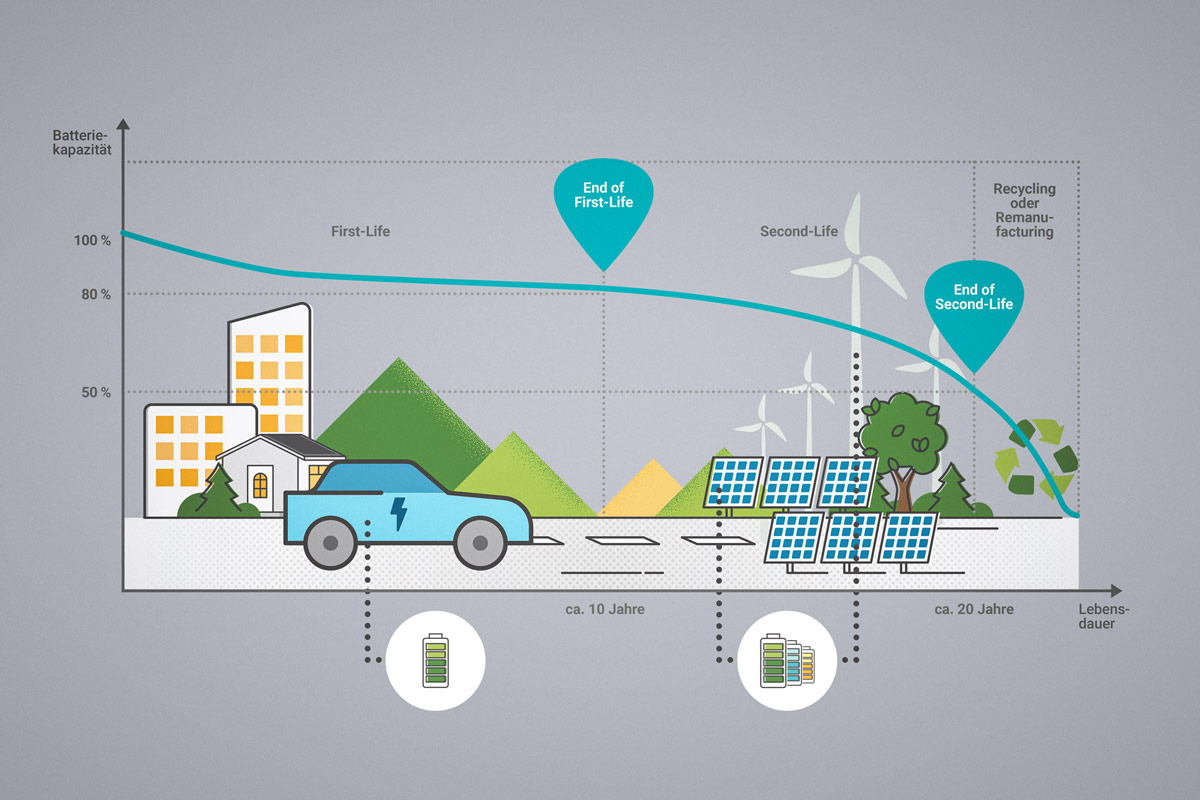This is how environmentally friendly electric cars are
At a glance
-
As part of the EU's climate protection targets, certain emission limits apply to road transport, which are to be reduced by 37.5% by 2030 compared to 2021. >>
-
In order to be able to achieve this goal, the expansion of electromobility is needed. Because electric cars are emission-free. >>
-
The production of e-cars causes more CO2 than those of vehicles with combustion engines, but they are still the much more environmentally friendly alternative over their entire service life. >>
-
Electric vehicles already cause 16-27% less climate-damaging exhaust gases than conventional cars with combustion engines. This balance will continue to increase with the expansion of renewable energies and the installation of private photovoltaic systems. >>
CO2emissions are not the same as CO2-Emission
Electric vehicles are commonly referred to as emission-free because, unlike a car with an internal combustion engine, they do not have any CO emissions when driving.2emissions. However, it should be noted that CO2emissions. The production of the electricity needed to operate an electric car also produces exhaust gases that are included in the environmental balance. But this much in advance: Despite everything, e-cars are clearly an environmentally friendly solution.
EU limit values and climate protection targets
Currently, around a quarter of all CO emissions are accounted for2emissions in the EU on road transport; Cars and trucks are responsible for the majority of this. For this reason, certain emission limits apply to road traffic, which were tightened again in October 2020. This means that the automotive industry will have to prepare for even stricter guidelines for CO emissions by 2030.2emissions of new cars: According to this, the CO2emissions by 60% compared to 1990 and by 37.5% compared to 2021.
The EU limits determine how much carbon dioxide a new car sold may emit on average. The climate targets are intended to help sustainably reduce emissions from road traffic and thus achieve climate protection targets. So far, new cars are not allowed to emit more than 95 grams of carbon dioxide per kilometer in 2021. This value applies to the so-called "fleet average per manufacturer". This means that the average of all vehicles registered in the EU this year should not exceed a certain value. To ensure that manufacturers who mainly produce heavy cars are not disadvantaged, the limit value will be adjusted according to the average weight of the registered vehicles. In addition, there are incentives, so-called "credits", for zero- and low-emission vehicles with a consumption of less than 50 gCO2/Km. These are given greater statistical weighting in the calculation of the fleet average.
For many manufacturers, not even the current targets are within reach, the European average was most recently 118.5 g CO2/Km. The EU limits can only be achieved if more and more pure electric cars are sold. By 2030, a share of electric vehicles of 35-40% of new registrations is necessary.
Overview of fleet limits
Currently, a fleet limit of 95 gCO applies2/Km. At the same time, the changeover to the new and more realistic WLTP test procedure will take place. This adjusts the values upwards by approx. 20 %, i.e. to approx. 115 gCO2/km according to the previous NEDC test procedure. Depending on the values of the new test procedure, the limit values from 2025 onwards will be given as a percentage reduction compared to 2021.
E-cars are as clean as the electricity they run on
E-cars are environmentally friendly and therefore essential for a climate-neutral future. Although they start with a minus in CO due to the energy-intensive production of the battery2emissions. This minus pays for itself all the faster the cleaner the operating electricity is produced. Due to the German electricity mix, which still has a large share of coal, this is taking a little longer than we would like. Nevertheless, according to the Federal Ministry for the Environment, Nature Conservation, Building and Nuclear Safety over the entire life cycle, however, significantly less CO2 than a combustion engine. The expansion of renewable energies will increase the climate advantage even further in the future.
Tip:
Anyone who charges their electric car with electricity from renewable energies drives in a particularly climate-friendly way. Ideally, the electricity comes from your own solar system: electric cars in combination with a photovoltaic system are as environmentally friendly, cost-effective and independent as possible.
Do you need support in making an e-car decision or don't know which wallbox is right for you? No problem: Test now in our digital buying guide how you can easily put together your individual e-mobility package.
Real electricity consumption must take charging losses into account
But how much electricity does an electric car need? The manufacturers state the consumption in the unit kilowatt hours per 100 kilometers (kWh/100 km). How far you can actually drive with the charging power depends on various factors. In general, the larger and heavier a vehicle, the higher its power consumption. It is not only how efficiently the electric motor works that is decisive. Losses are also incurred during charging, i.e. more energy is consumed than ultimately reaches the battery.
Currently, a long range is not necessarily achieved only with an energy-efficient vehicle, but above all with large batteries. It should be noted that speed and temperature can also have a significant impact on range. Despite everything, the energy costs per kilometer driven are significantly cheaper than with combustion engines.
Battery life and recycling
The battery is the heart of an electric car and is largely responsible for range and price. Battery technology has made great leaps in recent years. For example, the energy density of batteries has almost doubled with prices falling significantly. This means that e-car drivers today get more power with less weight for the same money.
The more charging cycles the battery allows, the slower it ages. Manufacturers usually give eight to ten years or 100,000–160,000 km warranty on the battery. This means that the capacity of the battery does not fall below 75% of the initial value within this time.
Second-Life Assignment
Depending on time and intensity of use, lithium-ion batteries lose capacity. Nevertheless, they are not worthless, because they can also be used sensibly for many years in second-life use, e.g. as stationary energy storage systems for wind turbines or photovoltaic systems. As a rule, after about 1,500-2,500 charging cycles, they still have an energy content of 70-80% of their original capacity. It therefore makes neither economic nor ecological sense to dispose of them in this condition. They can continue to be used in the so-called "Second Life" in stationary operation. Stationary operation has the advantage that charging and unloading are slower and gentler. This means that the battery can be used for another ten to twelve years.
Technically, more is possible than is currently required:
The raw materials contained in a battery, such as lithium and cobalt, are very valuable and are recovered through recycling. So far, electric car batteries have not yet been recycled on an industrial scale because there are not yet enough batteries to be recycled. The legal situation is also lagging behind in the area of recycling efficiency: Experts are therefore currently calling for a legal regulation of the recycling of used batteries.
In order to achieve the highest possible recycling rate, a procedure in several steps is necessary:
- Manual disassembly
- Sort
- Shred
- Thermal melting
- Material separation
As things stand today, a large proportion of the battery materials can be recovered, but some of the process steps are still very energy-intensive and expensive.
When it comes to the reuse and recycling of batteries, much more is technically possible than is currently required by regulation. The time until the point at which larger quantities of disused batteries are recycled must be used to create clear framework conditions for the processes.
Entire life cycle: manufacturing, operation, maintenance and disposal
The entire life cycle of the vehicle must be taken into account in an environmental balance: the production of all components, the operation and the energy required for it, losses between the power plant, socket and vehicle battery, maintenance costs and finally recycling and disposal. In all these phases of life, realistic consumption values should be used.
Environmental balance: 16-27% less climate-damaging CO2-Emissions
The carbon footprint of an electric car, or more precisely the specific climate-relevant emissions per vehicle kilometre over its entire service life, shows that the greenhouse gas emissions of a purely battery-electric vehicle are significantly lower than those of comparable vehicles with combustion engines, even taking into account the German electricity mix. The expansion of renewable energies will further increase the lead, although comparable vehicles with diesel or gasoline engines will also become more efficient. An electric car that is newly registered in 2025 will already emit 32-40% less CO over its lifetime.2emissions than a modern combustion engine.
Questions & Answers
How environmentally friendly are e-cars?
Electric cars are considered emission-free because they do not produce any greenhouse gases themselves. Only during production and charging is CO2 – but this is compensated for during operation. If you also rely on electricity from renewable energies for charging, this happens relatively quickly.
How environmentally friendly are plug-in hybrids?
The plug-in hybrid has a combustion engine and is therefore of course not emission-free. However, the built-in battery can provide valuable – climate-friendly – services, especially on short distances. Here, too, the more environmentally friendly the power source, the more environmentally friendly the vehicle.
How long will my battery last?
The lithium-ion battery integrated in your electric car lasts for about 500 to 1,200 charging cycles, which corresponds to a service life of around 8 to 10 years. Many manufacturers even guarantee a certain service life, a minimum mileage and a minimum remaining capacity.
What is the actual range of an electric car?
The American Automobile Association (AAA) has determined the range of electric cars in summer and winter by means of various tests. For example, summer and winter conditions were simulated. The result: In summer, around 17% range is lost when the air conditioning is running, and in winter it is around 41% when the heating is running. The rule of thumb for calculating the summer or winter range:
Manufacturer's specification in km – (17 % / 41 % of the manufacturer's specification in km) = range summer/winter in km




